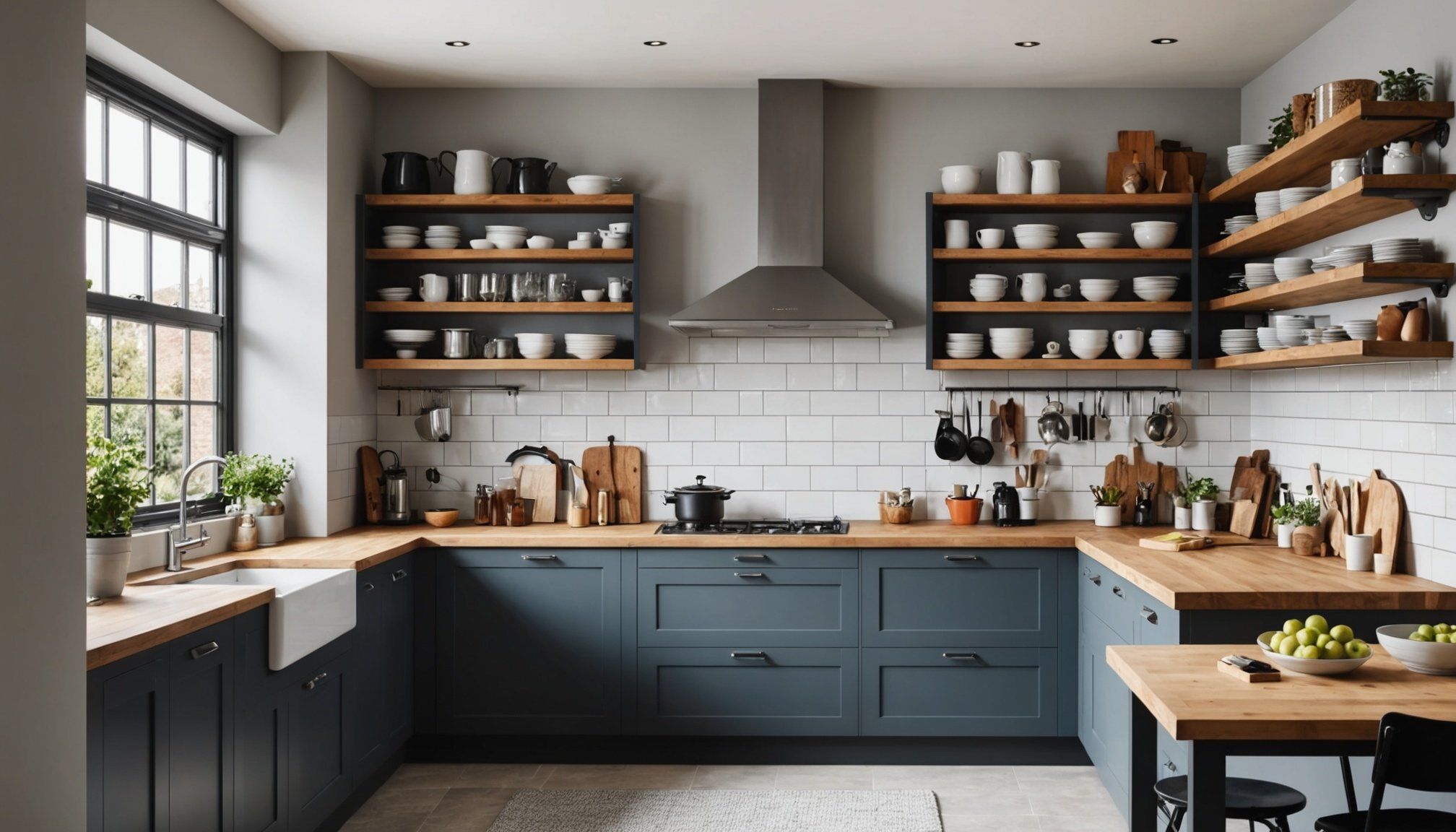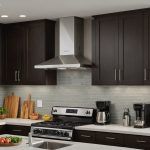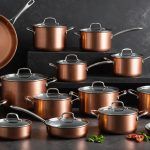How to Reduce Noise in Your UK Kitchen Using Stylish Open Shelving Solutions
When designing or renovating your kitchen, one of the often-overlooked but crucial aspects is noise reduction. A noisy kitchen can be distracting and stressful, especially in open-plan living spaces where the kitchen, living, and dining areas blend together. Here’s a comprehensive guide on how to reduce noise in your UK kitchen, incorporating stylish open shelving solutions and other practical tips.
Understanding the Sources of Noise in Your Kitchen
Before we dive into the solutions, it’s essential to identify the common sources of noise in your kitchen. These include:
In the same genre : Discover the Benefits of Copper Cookware for Your UK Kitchen: An Essential Guide!
- Kitchen Appliances: Dishwashers, refrigerators, and blenders are some of the noisiest appliances.
- Foot Traffic and Movement: The sound of footsteps, opening and closing cabinets, and moving around the kitchen.
- Cooking and Preparation: Pots and pans clanging, utensils being used, and the sound of food preparation.
- Conversation and Media: Voices from family members or guests, and the sound from TVs or radios.
Designing Your Kitchen for Noise Reduction
Planning Your Kitchen Layout
A well-planned kitchen layout can significantly help in reducing noise. Here are some tips to consider:
- Zone Creation: Divide your kitchen into different zones, such as a cooking zone, a preparation zone, and a cleaning zone. This can help distribute the noise more evenly.
- Appliance Placement: Place noisy appliances like dishwashers and refrigerators away from the main living areas. Consider installing them against walls that are not shared with living spaces.
- Traffic Flow: Plan the traffic flow in your kitchen to minimize foot traffic near noisy areas.
| Zone | Tips for Noise Reduction |
|
|-------------------------------------------------------------------------------------------|
| Cooking Zone | Use sound-absorbing materials like acoustic panels near the cooking area. |
| Preparation Zone | Choose quiet utensils and tools. Use a silent or soft-close drawer system. |
| Cleaning Zone | Place the dishwasher and sink in a corner to reduce the spread of noise. |
Incorporating Open Shelving Solutions
Open shelving can be both stylish and functional in reducing noise. Here’s how you can use it effectively:
Have you seen this : Comprehensive guide to selecting ideal kitchen island lighting for your home in the uk
- Sound-Absorbing Materials: Use open shelving made from sound-absorbing materials like wood or incorporate sound-absorbing panels within the shelving design.
- Strategic Placement: Place open shelving in areas where it can act as a buffer between the kitchen and the living space. For example, a kitchen island with open shelving can help absorb some of the noise.
- Decorative Elements: Add decorative elements like plants, baskets, or acoustic art pieces on the shelves to enhance sound absorption.
Acoustic Solutions for Your Kitchen
Using Acoustic Panels
Acoustic panels are a great way to reduce echo and ambient noise in your kitchen. Here’s how you can integrate them:
- Wall Installation: Install acoustic panels on walls, especially in areas where sound tends to bounce around, like near the cooking station.
- Ceiling Installation: Consider installing acoustic panels on the ceiling to reduce reverberation.
- Material Selection: Choose materials that are known for their sound-absorbing properties, such as foam, fabric, or specialized acoustic materials.
Sealing Gaps and Cracks
Gaps and cracks in your kitchen can let noise escape and enter. Here’s how to seal them effectively:
- Door Seals: Use door seals or weatherstripping around doors to prevent noise from escaping or entering.
- Window Seals: Ensure windows are properly sealed with weatherstripping or acoustic window seals.
- Cabinet Seals: Use soft-close hinges and seals on cabinets to reduce the noise from opening and closing.
Stylish and Functional Solutions
Cabins and Booths
Inspired by office acoustic cabins, you can create similar solutions in your kitchen:
- Acoustic Booths: Install small acoustic booths or phone boxes in your kitchen for quiet conversations or video calls.
- Kitchen Islands: Design a kitchen island with built-in acoustic features like sound-absorbing materials or panels.
| Solution | Description |
|
|--------------------------------------------------------------------------------------------------|
| Acoustic Booths | Compact, sound-proofed spaces for quiet conversations or video calls. |
| Kitchen Islands | Islands with built-in sound-absorbing materials or panels to reduce ambient noise. |
Quiet Mark Certified Appliances
Choosing appliances that are Quiet Mark certified can significantly reduce the overall noise level in your kitchen:
- Dishwashers: Look for dishwashers with low decibel ratings.
- Refrigerators: Opt for refrigerators with silent operation features.
- Blenders and Mixers: Choose blenders and mixers with noise-reduction features.
Practical Tips for a Quieter Kitchen
Here are some practical tips to help you achieve a quieter kitchen:
Regular Maintenance
- Regularly maintain your appliances to ensure they run smoothly and quietly.
- Clean your kitchen regularly to reduce the noise from clutter and mess.
Sound-Absorbing Decor
- Use sound-absorbing decor items like rugs, curtains, and wall hangings to reduce echo and ambient noise.
- Incorporate plants, which not only absorb sound but also purify the air.
Smart Placement of Appliances
- Place noisy appliances on anti-vibration mats to reduce the noise they produce.
- Use appliance silencers or noise-reducing covers for items like blenders and mixers.
Creating a quieter kitchen is not just about reducing noise; it’s about enhancing the overall living experience in your home. By incorporating stylish open shelving solutions, using acoustic panels, sealing gaps and cracks, and choosing Quiet Mark certified appliances, you can significantly reduce the noise level in your kitchen.
As Sarah Jones, a home designer, notes, “A quiet kitchen is not just a luxury; it’s a necessity in today’s open-plan living spaces. By integrating sound-absorbing materials and smart design elements, you can create a kitchen that is both stylish and peaceful.”
In summary, with a little planning, the right materials, and some practical tips, you can transform your kitchen into a quieter, more enjoyable space that complements your entire home.
Image Credit
- For images of acoustic panels and open shelving solutions, consider using stock photos from reputable sources like Unsplash or Pexels.
Additional Resources
- For more detailed information on acoustic materials and their applications, refer to resources like the Acoustic Society of America.
- For Quiet Mark certified appliances, visit the Quiet Mark website for a list of certified products.
Importance of Noise Reduction in UK Kitchens
Kitchens in the UK are bustling, vibrant spaces but can often be plagued by unwanted noise. Common sources include the clatter of pots and pans, the hum of appliances, and the chatter of social gatherings. Understanding kitchen acoustics is essential for creating a more pleasant environment.
Excessive noise can turn cooking into a stressful activity and reduce the enjoyment of social experiences. Imagine trying to concentrate on a recipe while the extractor fan roars or holding a conversation with friends over the whirring of a blender—such distractions impact the overall vibe of a gathering.
Embracing noise reduction techniques can transform your kitchen into a haven of peace. Benefits are vast: enhanced communication, reduced stress, and improved focus. Opting for quieter appliances, installing sound-absorbing materials like carpets or acoustic panels, and applying clever design choices are effective strategies.
Ultimately, investing in noise mitigation not only elevates the cooking experience but also fosters an atmosphere where social interactions can thrive. So, as you plan your next kitchen update, pay attention to the acoustics. It can make all the difference between a noisy din and a harmonious retreat.
Stylish Open Shelving Solutions
Open shelving has become a staple in stylish kitchen design, especially in the UK, where home decor trends often emphasize both aesthetics and functionality. There are various types of open shelving available, each offering its unique charm and practicality. Whether you prefer rustic wooden shelves for a traditional look or sleek metal ones for a modern vibe, the options are plentiful. The right choice can transform your kitchen space into a haven of style and efficiency.
Adding open shelving to your kitchen design not only enhances the aesthetic appeal but also increases functionality. It provides easy access to everyday items while displaying your favourite kitchenware or decorative pieces. This creates a functional yet visually appealing setup, turning your kitchen into a central feature of your home.
However, achieving a balance between style and functionality with open shelving requires careful consideration, particularly concerning acoustics. Kitchens can be noisy spaces, and open shelving might contribute to increased sound reverberation. Opting for materials that absorb sound or strategically placing textiles like linens can help mitigate this issue while maintaining an elegant design. By focusing on these subtle details, you can create a kitchen that is both stylish and practical, reflecting your personal taste and lifestyle.
Effective Soundproofing Techniques
Achieving a quieter kitchen environment can significantly enhance the joy of cooking and entertaining. Let’s explore some effective techniques.
Selecting Sound-Absorbing Materials
Using soundproofing materials can greatly aid in kitchen noise management. Choosing the right acoustic materials is crucial. Materials that reduce sound reflections include soft furnishings and textiles. These can absorb noise, contributing to a more serene kitchen space. Considerations span from plush rugs to heavy curtains. They all have a role in absorbing unwanted echoes.
For more directed interventions, acoustic panels offer substantial advantages. These panels, available in various designs, can be mounted on walls or ceilings. They work tirelessly to minimize reflections and diffusions of sound waves. This results in an overall calming effect within the culinary area.
Smart Layout Choices
The strategic arrangement of kitchen elements plays a pivotal role in managing acoustics. Open shelving can influence sound dynamics by providing less surface for noise to bounce off. Go for closed cabinetry where possible, creating more defined zones. This helps in minimizing noise transfer between areas, thereby enhancing relaxation. Employing cabinetry and barriers can aid in distributing sounds more effectively, ensuring they do not resonate through the entire room.
Enhancing Wall and Floor Surfaces
Selecting the right wall and floor surfaces can be key to effective soundproofing. Materials specifically engineered for sound-dampening purposes can be aesthetic yet functional. For the floor, options vary from cork to vinyl, aptly minimizing noise transmission. Decorative wall treatments, such as textured wall panels, not only add a visual appeal but also actively contribute to noise control. These choices provide a practical approach to maintaining harmony and tranquility in your kitchen environment.
Functional Design Ideas for Open Shelving
Designing a functional kitchen can transform how you interact with your space, with open shelving organization playing a crucial role. A well-arranged shelf not only looks inviting but also boosts kitchen efficiency. One common concern with open shelving is managing noise when accessing items. A strategic approach can help minimize bothersome sounds, such as the clatter of dishes and utensils.
Organizing utensils and dishes is paramount. Arrange them logically to ensure that everyday items are within easy reach but securely placed to stay quiet during retrieval. Grouping similar items together reduces searching time and potential noise.
Incorporating baskets and containers is an excellent strategy. These can act as barriers, preventing items from colliding and muffling sound. Woven baskets offer a soft, noise-absorbing surface, while clear containers can provide sturdy protection while keeping contents visible.
Creative placement of items further enhances access and reduces noise. Place heavier and less frequently used objects on the lower shelves. Store delicate glassware or frequently-used dishes on upper shelves where they’re less likely to be jostled. This kind of thoughtful organization fosters a harmonious blend of accessibility and tranquility in your open shelving design.
Case Studies of Stylish UK Kitchens
Explore the world of kitchen design inspiration with open shelving examples and discover how UK kitchen trends blend functionality with style.
Reviewing Local Design Influences
In the UK, popular kitchen styles range from sleek, modern designs to charming, rustic aesthetics. A key element in these kitchens is open shelving, which can be seamlessly incorporated into various design aesthetics. Sleek metal shelves suit modern kitchens, while wooden shelvres lend warmth to traditional styles.
Innovative noise reduction strategies are also gaining traction. Kitchens that successfully reduce noise often combine sound-absorbing materials with smart layout planning. For instance, installing sound-dampening panels above and below open shelves can minimize sound reflection, creating a peaceful cooking environment.
Product Recommendations
When seeking stylish shelving options that support sound reduction, consider brands like String Furniture and Vipp. They offer options that are not only functional but also align with contemporary UK kitchen trends. To personalize your open shelving while maintaining quietness, use decor items like fabric storage bins or lined wicker baskets that help absorb sound.
Visual Examples and Diagrams
Visual representation plays a pivotal role in understanding kitchen acoustics. Viewing images and diagrams can offer a clearer picture of sound flow in kitchen layouts. Additionally, before-and-after comparisons can vividly illustrate effective noise reduction strategies. These visuals can serve as powerful kitchen design inspiration.











